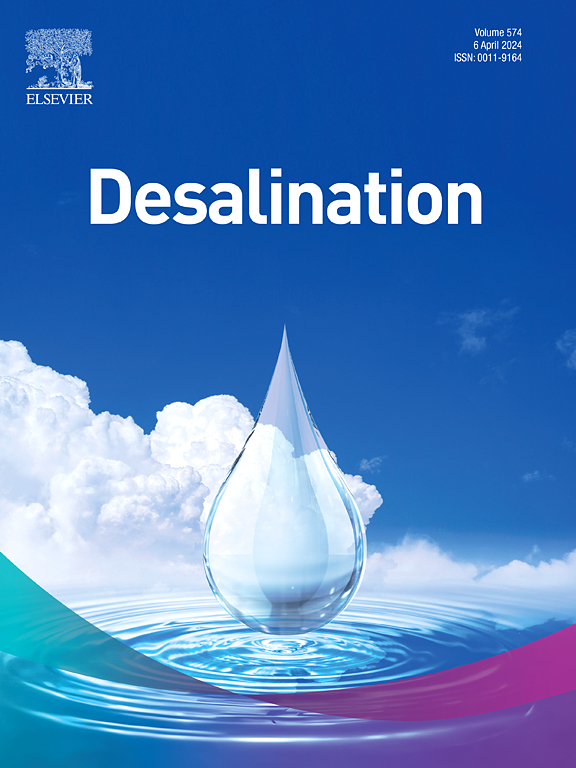层间扩展的 1T 相 MoS2 作为增强型电容式去离子阴极材料
IF 8.3
1区 工程技术
Q1 ENGINEERING, CHEMICAL
引用次数: 0
摘要
二硫化钼(MoS2)具有较大的表面积和理论电容,是电容式去离子(CDI)电极的潜在材料。然而,它的低导电性和有限的层间距阻碍了海水淡化性能的提高。在我们的研究中,我们结合了相位调制和层间工程方法,创造出一种由金属相 MoS2 制成的 CDI 电极材料,并扩大了层间间距。金属相的高电导率促进了电荷的快速传输,而扩大的层间距(从 6.2 Å 增加到 9.8 Å)促进了活性位点的有效利用,并降低了离子扩散的障碍。这种电极具有显著的比电容(10 mV s-1 时为 131.1 F g-1)和较高的电容贡献率(81%)。此外,在 200 毫克/升的氯化钠溶液中,它的脱盐能力高达 47.1 毫克/克-1,脱盐速度快达 2.4 毫克/克-1 分钟-1。此外,我们的密度泛函理论(DFT)计算还验证了扩大的层间间距在促进 Na+ 插入和加速其扩散动力学方面所起的重要作用。本文章由计算机程序翻译,如有差异,请以英文原文为准。
Interlayer-expanded 1T-phase MoS2 as a cathode material for enhanced capacitive deionization
Molybdenum disulfide (MoS2) is a potential material for capacitive deionization (CDI) electrodes due to its large surface area and theoretical capacitance. However, its low electrical conductivity and limited spacing between layers hinder the improvement of the desalination performance. In our research, we combined phase modulation and interlayer engineering methodologies to create a CDI electrode material made of metallic phase MoS2 with expanded interlayer spacing. The high conductivity of the metallic phase facilitates rapid charge transport, while the expanded interlayer spacing (increased from 6.2 Å to 9.8 Å) promotes effective utilization of active sites and reduces the barriers for ion diffusion. The created electrode showcases a notable specific capacitance (131.1 F g−1 at 10 mV s−1) and an elevated capacitive contribution percentage (81 %). Additionally, it demonstrates a high desalination capacity of 47.1 mg g−1 and a fast desalination rate of 2.4 mg g−1 min−1 in a 200 mg L−1 NaCl solution. Furthermore, our density functional theory (DFT) calculations validate the essential role played by enlarged interlayer spacing in promoting Na+ insertion and accelerating its diffusion kinetics.
求助全文
通过发布文献求助,成功后即可免费获取论文全文。
去求助
来源期刊

Desalination
工程技术-工程:化工
CiteScore
14.60
自引率
20.20%
发文量
619
审稿时长
41 days
期刊介绍:
Desalination is a scholarly journal that focuses on the field of desalination materials, processes, and associated technologies. It encompasses a wide range of disciplines and aims to publish exceptional papers in this area.
The journal invites submissions that explicitly revolve around water desalting and its applications to various sources such as seawater, groundwater, and wastewater. It particularly encourages research on diverse desalination methods including thermal, membrane, sorption, and hybrid processes.
By providing a platform for innovative studies, Desalination aims to advance the understanding and development of desalination technologies, promoting sustainable solutions for water scarcity challenges.
 求助内容:
求助内容: 应助结果提醒方式:
应助结果提醒方式:


